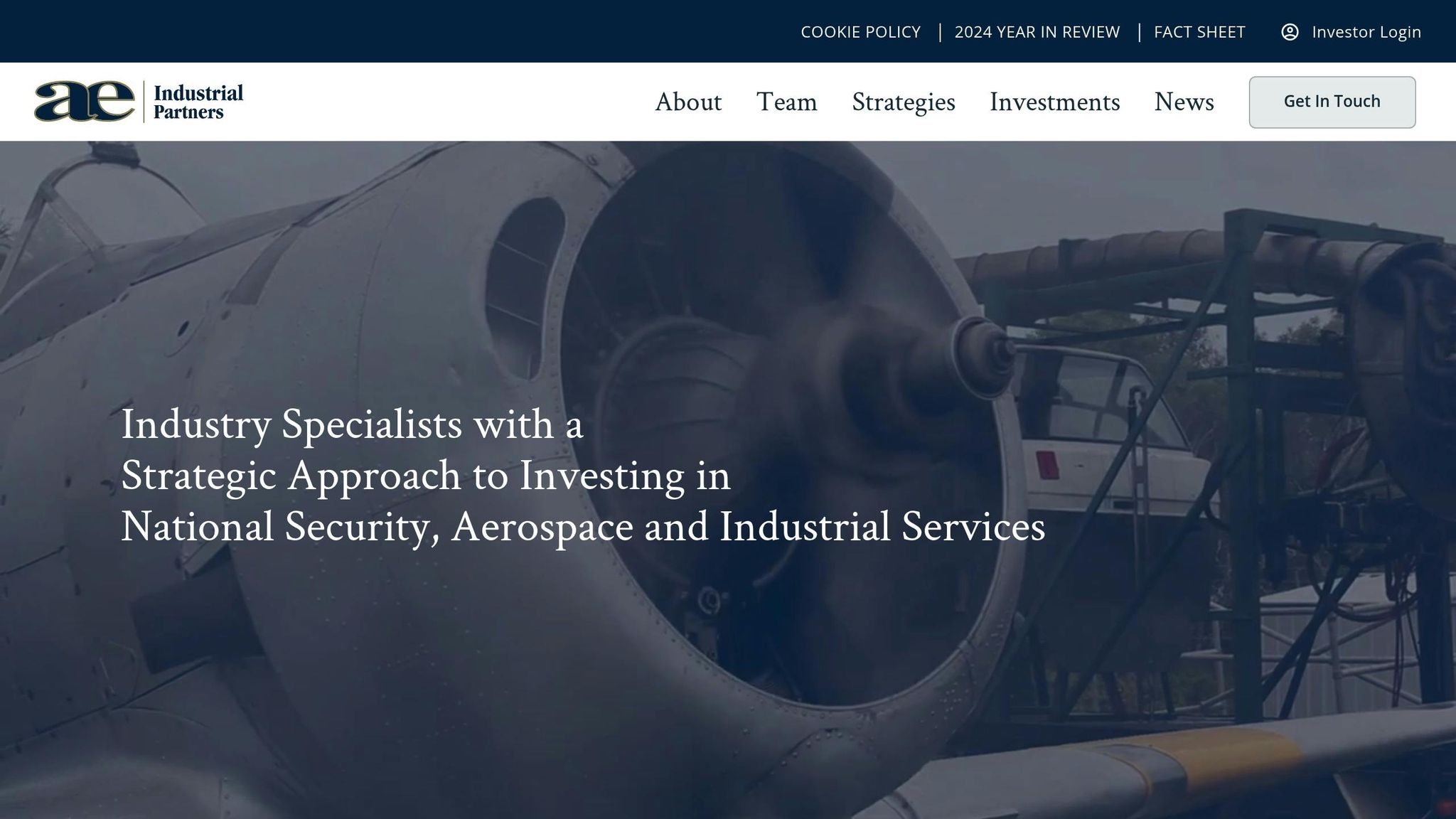Private Equity Buyouts in Space Tech: 2025 Outlook
Explore the evolving landscape of private equity in space tech, driven by growth areas, investment trends, and regulatory challenges.

Private equity is reshaping the space technology industry in 2025. Rising defense budgets, technological advancements, and investor confidence are driving buyouts, mergers, and acquisitions. Key players like SpaceX are attracting attention with diverse revenue streams and pre-IPO opportunities. Here's what you need to know:
- Growth Areas: Satellite internet, orbital manufacturing, and debris removal are gaining traction.
- Investment Trends: Shift from minority stakes to majority buyouts, larger deal sizes, and global expansion.
- Challenges: Regulatory scrutiny, high capital requirements, and limited liquidity remain hurdles.
- Opportunities: Government contracts, secondary market platforms, and diversified portfolios offer stability and growth potential.
SpaceX stands out with its reusable rocket technology and ventures like Starlink, making it a prime target for private equity interest. For investors, understanding this sector's dynamics and risks is crucial for success.
Kirk Konert, AE Industrial Partners

1. SpaceX Stock Investment Guide

SpaceX has become one of the most talked-about private investment opportunities in the space technology sector. Unlike traditional aerospace companies that lean heavily on government contracts, SpaceX has built a diverse revenue stream. This includes commercial satellite launches, partnerships with NASA, and the rapidly growing Starlink satellite internet service. Together, these elements form a solid foundation for its impressive market performance.
Over time, SpaceX has consistently achieved technological milestones while securing significant funding through multiple rounds. This strategy has opened the door for private investors to get in on the action before the company eventually goes public. Naturally, this has drawn the attention of private equity firms eager to tap into high-growth opportunities in the space industry.
The company's valuation trends have shown a steady upward trajectory, making it a standout in private equity portfolios. By investing in SpaceX, investors gain exposure to various segments of the space economy - everything from satellite internet to commercial launches - all through a single investment.
For those interested in exploring investment opportunities with SpaceX, the SpaceX Stock Investment Guide is an excellent resource. It offers detailed insights into pre-IPO investment strategies, funding rounds, valuation trends, and the broader private equity landscape within the space technology industry.
SpaceX’s future prospects only add to its appeal. With ambitious plans like Starship missions to Mars, the global expansion of Starlink, and a growing share of the commercial launch market, the company is positioned for long-term growth. This mix of proven success and bold future goals makes SpaceX a highly attractive option for private equity investors.
What truly sets SpaceX apart is its operational scale and dominance in the market. By pioneering reusable rocket technology, SpaceX has dramatically lowered costs in the launch industry, creating a competitive edge that rivals find hard to match. This operational efficiency and market leadership make it a compelling investment in the evolving space sector.
2. General Private Equity Trends in Space Tech (2021–2025)
Since 2021, private equity (PE) activity in the space technology sector has undergone a major transformation. The industry's rapid growth has spurred aggressive buyouts, marking a shift in how PE firms approach investments in this field. Let’s break down the key trends shaping this dynamic period from 2021 to 2025.
Investment volumes and deal sizes have grown significantly. PE interest has expanded beyond traditional areas like satellite manufacturing to newer fields such as data analytics, space-based manufacturing, and orbital debris removal. This shift highlights how the space economy is evolving and diversifying.
In terms of strategy, PE firms have moved from holding minority stakes to pursuing majority buyouts. This transition reflects their increasing confidence in taking control of established space tech companies. With more capital and expertise at their disposal, major PE firms are driving up valuations and accelerating deal timelines.
Geographically, the focus has broadened. While U.S.-based companies remain a central interest, European space tech firms have attracted growing attention. This global expansion signals a search for opportunities beyond domestic markets, as the sector becomes increasingly interconnected.
Exit strategies have also improved. Options like strategic acquisitions and public market listings are encouraging more aggressive bidding, which in turn is driving up entry valuations. Additionally, PE deals are placing greater emphasis on cost reduction and streamlining supply chains - tactics borrowed from aerospace and defense industries.
The regulatory landscape has played a significant role as well. Rising government scrutiny of foreign investments in sensitive technology areas has made PE firms more selective, especially when it comes to companies with critical government contracts. However, this environment has also created new opportunities for domestic investors to step in.
These trends collectively highlight the momentum behind private equity investments in space tech, underscoring the sector’s growing appeal to major players in the investment world.
Pros and Cons
Investing in private equity within the space technology sector comes with both exciting opportunities and notable challenges. Understanding these factors can help investors make informed decisions in this rapidly evolving industry.
| Advantages | Disadvantages |
|---|---|
| Strong Growth Potential – The sector has seen impressive valuation increases in recent years. | Limited Liquidity – These investments are often long-term, with fewer options for quick exits. |
| Diversified Revenue Streams – Companies span areas like satellite manufacturing, data analytics, and orbital services. | Regulatory Considerations – Government scrutiny can create additional compliance hurdles. |
| Attractive Acquisition Prospects – Established aerospace firms are actively acquiring space tech assets. | High Capital Requirements – Significant funding needs often limit participation to accredited and institutional investors. |
| Stable Government Contracts – Partnerships with agencies like NASA provide a reliable revenue base. | Technical Risks – Operational setbacks and technological challenges can quickly impact valuations. |
These factors highlight the dynamic nature of private equity investments in space technology. While the sector offers considerable growth opportunities, it also demands careful navigation of its unique risks.
Private equity in space tech typically requires a long-term commitment and higher investment thresholds. Resources like the SpaceX Stock Investment Guide can help investors understand these private market opportunities. Platforms such as UpMarket also play a role by enabling secondary market transactions, offering some liquidity in an otherwise illiquid market.
The regulatory landscape presents a double-edged sword. On one hand, increased oversight protects domestic investors and national interests. On the other, it can restrict foreign investments and add layers of complexity to compliance processes.
Risk management is essential in this highly technical field. Savvy investors often mitigate risks by diversifying their portfolios across different space tech subsectors and development stages.
The sector's growing appeal has intensified competition among private equity firms. Those with deep aerospace expertise and strong industry connections are better positioned to identify and secure high-quality deals, particularly in buyout strategies. This competitive edge underscores the importance of thorough due diligence in such a specialized and fast-paced market.
Conclusion
The private equity landscape in space technology has come a long way since its early speculative days. By 2025, the focus has shifted to acquiring companies with solid revenue streams and well-established market positions, signaling a more mature and strategic approach to investment.
Several factors are driving this transformation. Government contracts with agencies like NASA and the Department of Defense play a critical role, providing stability and credibility to these investments. However, liquidity challenges persist. With IPOs still rare, investors often turn to strategic acquisitions and secondary market platforms as alternative exit strategies.
For those navigating this evolving sector, resources like the SpaceX Stock Investment Guide offer valuable insights. This guide breaks down pre-IPO and private equity strategies tailored to the space tech market. Additionally, its free Investor Club keeps members informed with updates on SpaceX stock and private equity education.
Today’s competitive buyouts require more than just financial resources. Investors need a deep understanding of aerospace, strong industry networks, and the ability to navigate regulatory hurdles. While these regulations add complexity, they also safeguard domestic interests, prompting investors to adapt and thrive within these boundaries.
The shift from speculative investments to mature private equity highlights the commercial potential of space tech. With growth areas like manufacturing and orbital logistics gaining traction, the sector presents sophisticated and rewarding opportunities for investors who grasp its unique dynamics.
FAQs
What factors are driving private equity interest in space technology in 2025?
Private Equity's Growing Interest in Space Technology
The space technology sector is drawing significant attention from private equity firms in 2025, and it’s not hard to see why. U.S. companies poured a record-breaking $3.1 billion into the industry in just the second quarter of the year, showcasing strong domestic confidence in its potential. With the sector’s valuation projected to hit a staggering $800 billion by 2027, it’s clear that this is a market on the rise.
What’s fueling this momentum? Rapid advancements in areas like satellite manufacturing, space infrastructure, and strategic acquisitions are playing a big role. At the same time, a wave of startup activity and new market opportunities is making space tech more appealing than ever. As demand for cutting-edge space solutions grows, private equity firms are jumping at the chance to invest in this fast-evolving industry.
Why does SpaceX's reusable rocket technology make it attractive for private equity investments?
SpaceX has revolutionized the space industry with its reusable rocket technology, creating a massive shift in launch economics. Take the Falcon 9, for instance - each launch costs about $15 million, a staggering difference compared to the typical industry range of $100–$200 million. This cost reduction is made possible by reusability, as rockets like the Falcon 9 and Starship can be relaunched multiple times with the same hardware.
But there’s more to SpaceX’s success than just reusability. The company’s vertical integration and in-house manufacturing allow it to streamline operations and cut costs even further. By managing everything under one roof, SpaceX boosts efficiency and enhances profitability, solidifying its position as a leader in space technology. For private equity investors, this makes SpaceX a compelling choice, especially for those eyeing high-growth opportunities in satellite services and space access.
What regulatory challenges do private equity investors face in the space technology sector?
Regulatory Challenges for Private Equity in Space Technology
Investing in the space technology sector isn’t without its hurdles, especially when it comes to navigating complex regulations. Private equity investors face strict government policies aimed at protecting national security and ensuring technological self-reliance. A major sticking point? Compliance with export controls like the International Traffic in Arms Regulations (ITAR), which strictly govern the transfer of sensitive technologies. On top of that, foreign investments - particularly those tied to nations such as China and Russia - are under intense scrutiny.
But that’s not all. Government agencies are ramping up oversight to prevent monopolistic behavior and protect critical infrastructure, adding another layer of complexity to the investment process. For investors, this means due diligence isn’t just a box to check; it’s a deep dive into legal and political risks. Staying ahead of regulatory changes and ensuring compliance is crucial to avoiding costly roadblocks in the fast-evolving world of space technology.
Comments ()